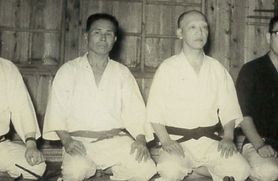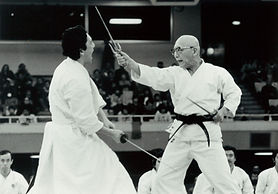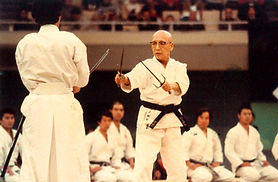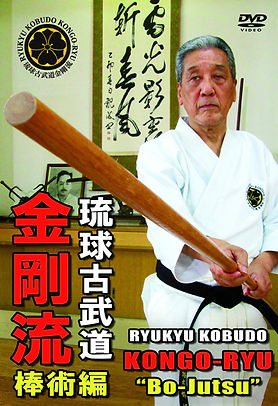

Ryukyu Kobudo Kongo-ryu was an Okinawan weaponary martial arts style that was created by the martial artist, Ryusho Sakagami. He received the first Shihan license from the modern pioneer of Kobudo, Master Shinken Taira. It is also the oldest kobudo school in mainland Japan. The character of the style has been influenced by other martial arts styles from mainland Japan, such as Kendo, Jodo, and Iaido.


Master Taira and Master R. Sakagami

Demonstration of Sai vs Sword
at Nippon Budo-kan (Japan)

Demonstration of Sai vs Sword
at Nippon Budo-kan (Japan) #2
Ryukyu kobudo is a hand-weapon art that finds its origins in the ancient Ryukyu Islands (present-day Okinawa). It uses a variety of long and short weapons, typically including the bo (staff, also known as kon), sai (iron fork), tonfa (millstone handle), nunchaku (horse bridle), and nicho kama (two sickles). Each has unique features, making them unlike other weapons found around the world.
The weapon art of Ryukyu kobudo and the weaponless art of karatedo were originally two sides of the same coin. While karatedo became remarkably popular, however, Ryukyu kobudo remained relatively unknown. Master Yabiku Moden (1878-1841) and Master Mabuni Kenwa (1889-1952) were concerned about this and worked to promote Ryukyu kobudo and preserve its kata.
Master Taira Shinken (1897-1970), who was a student of Yabiku Moden and is celebrated for his role in revitalizing Ryukyu kobudo, established the Ryukyu Kobudo Hozon Kenkyukai (Society for the Preservation and Research of Ryukyuan Kobudo) in 1940. He brought together eight types of Ryukyu kobudo as one discipline and devoted the rest of his life to promoting it.
From 1957, Taira Shinken resided for some time with the Sakagami family and taught Ryukyu kobudo at the Itosu-kai Headquarters. Many of the Ryukyu kobudo kata handed down in our style come from Taira Shinken. Others are from Mabuni Kenwa.
When Taira Shinken established the Ryukyu Kobudo Hozon Shinkokai (Society for the Preservation and Promotion of Ryukyuan Kobudo) in November 1961, he appointed Master Sakagami Ryusho (1915-1993) as the head of the Kanto region.
Sakagami Ryusho was awarded the first Shihan certificate in May 1960. In 1963, he was awarded Hanshi 8-dan after contributing significantly to the promotion of kobudo.
Sakagami Ryusho’s son, Sakagami Sadaaki, started learning karatedo and kendo from his father in 1954. From 1960, he was instructed by Taira Shinken, and in November 1969, the Okinawa Headquarters of the Ryukyu Kobudo Hozon Shinkokai (Society for the Preservation and Promotion of Ryukyuan Kobudo) appointed him Shihan and head of the Kanto Region. Sakagami Sadaaki appears in photographs in works such as the Ryukyu Kobudo Shirizu I-III and Nunchaku Sai by Sakagami Ryusho. During the First World Championships held by the World Union of Karate-do Organizations (WUKO) in Tokyo in October 1970, Sakagami Sadaaki wowed the audience with a Ryukyu kobudo sai and sword demonstration.
Sakagami Ryusho’s book Ryukyu Kobudo Shirizu I Nunchaku Kihon-gata, published in April 1968, was the first kobudo instruction book available in both Japanese and English and received much attention outside Japan. When Sakagami Ryusho visited the United States, he had the opportunity to meet actor Bruce Lee's mother, Grace Ho. She told Sakagami Ryusho that her son had studied how to use the nunchaku from this book.
After Taira Shinken passed away, our style continued in the Ryukyu Kobudo Hozon Shinkokai Kanto Hombu. Then, in January 1984, Sakagami Ryusho incorporated the strengths of other budo that he had studied and founded Ryukyu Kobudo Kongo-ryu.
Kongo-ryu uses logical weapons techniques that have been passed down from one generation to the next over many years. Sakagami Sadaaki, who became Shuseki Shihan (chief instructor) of Kongo-ryu, is also highly skilled in kendo, jodo and iaido, and he established a system of Kongo-ryu techniques by complementing Kongo-ryu with findings from his own research. In April 2010, he established the Ryukyu Kobudo Kongo-kai to promote Kongo-ryu.
Ryukyu kobudo Kongo-ryu is currently working as a different organization from Itosu-ryu Karatedo International Federation. It is open to any karate style's people. However, the body mechanics which are necessary for Kongo-ryu is based on Itosu-ryu Karatedo. So, it makes easier for Itosu-ryu practitioners to master this weapon style.
If you want to know more about Ryukyu Kobudo Kongo-ryu. Please go to the homepage from the following link.

DVD is available now!
BO / KON
Kihon Kata #1
Kihon Kata #2
Kihon Kata #3
Shushi no Kon Sho
Ryusei no Kon
Shushi no Kon Dai
Sakugawa no Kon Sho
Kongo no Kon
Tsuken Bo: Maikata
Yonegawa no Kon (Hidari Bo)
Shirotaru no Kon
Others....
SAI
Kihon Kata #1
Kihon Kata #2
Kihon Kata #3
Ryubi no Sai
Tsuken Shitahaku no Sai
Tawada no Sai
Chatan Yara no Sai
Hamahiga no Sai
Hantagawa Kouraguwa no Sai
Yakaa no Sai
TEKKO
Maezato no Tekko
TONFA
Kihon Kata #1
Kihon Kata #2
Kihon Kata #3
Hamahiga no Tonfa
NUNCHAKU
Kihon Kata #1
Kihon Kata #2
Kihon Kata #3
Kongo no Nunchaku Sho
Kongo no Nunchaku Dai
KAMA
Kongo no Nicho Kama
Tozan no Nicho Kama
Kanegawa no Nicho Kama Sho
KAI
Tsuken Sunakake
(Kai no Kata)
TINBE and ROCHIN
Kanegawa no Tinbe



